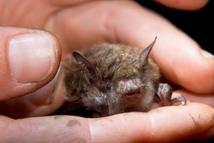saveourplanetearth.com
Call us: (775) 831-1331
For the Love of Bats
Imagine being out for a walk in the early evening and you happen to look up and see an enormous bat with a wingspan of about five feet, flapping overhead, peering down at you. It could happen, if you happen to be in the Philippines.
You would be observing the giant golden-crowned flying fox, also known as the golden-capped fruit bat, which eats—not humans, insects, tarantulas or mice—but fruit, primarily figs and leaves of the lowland forests in the Philippines.
You would also be fortunate to see one as they are endangered and rare, thanks to loss of habitat as well as extensive hunting, desired for its meat and pelt.
Since the early 1900s, total forest coverage of the Philippines has been reduced from 90% to 20%, with only 10% of the original forest lowland remaining. The fruit bat remains in the forest much of the time and avoids inhabited areas.
Bats are the second largest order of mammals, after rodents, and are divided into two subspecies: megabats, of which the fruit bat is one, and echolocating microbats, which we have here in the United States.
Megabats are predominantly fruit-eating, finding food using sight and smell and exist in tropical or subtropical climates. Microbats mainly eat insects but the larger of these will eat small mammals, amphibians or fish.
Microbats hunt at night using a process called echolocation, similar to sonar used by submarines. The bat emits ultrasonic sounds to produce echoes, which are then analyzed, providing detailed images of the bat’s surroundings. Using these images, the bat can even classify its prey in complete darkness, hone in on the prey’s location and snatch it out of the air, consuming 500 to 1200 mosquito-sized insects per hour, perhaps 4000 to 8000 insects per night.
There are three species of vampire bats within the microbat suborder that feed solely on blood. Vampire bats are native to the Americas in the southern regions: Mexico, Argentina, Brazil and Chile.
Vampire bats are not quite as dramatic as lore would have it. They will alight upon a larger animal, make a tiny incision, lap up a few drops of blood, and fly away. Many times the host animal will not even realize it was dined upon.
Children can learn about bats in the Sierra by participating in one of the programs given by Tahoe Institute for Natural Science (TINS). Teachers, check out the website tinsweb.org to find out how to include your class in these programs: “Mysterious Bats”, exploring the lives and habits of bats. Children will be able to examine real specimens and will learn the ecological importance of bats.
During another program, “How Are Bats Like People?,” students have the opportunity to take their own heart rates, then compare these to the heart rates of bats and learn about bat adaptations.
Sixteen bat species have been recorded in the basin (TINS keeps track of these and many other species), most of which are believed to migrate out of the basin for winter. Bats can’t function in the cold so they either migrate or hibernate, sometimes in large groups huddled together deep within caves.
This necessary means of survival can lead to the transmission of a fungus causing white nose syndrome which has decimated bat populations since 2006, when the fungus was first discovered in central New York State; some colonies experiencing a 90 to 100% mortality rate.
The fungus is native to Europe where it is naturally present in the biota (the total collection of organisms of a geographic region or time period) on the walls of caves and is harmless to the species of bats there but is proving devastating to North American bats.
Bats have a lifespan of up to 20 years but can succumb in one season after having contracted white nose syndrome. The fungus grows on the muzzles, ears and wings of afflicted bats, desiccating the bat’s wings, making it more difficult to fly and feed. It also causes extreme thirst during hibernation, causing the bat to awaken to feed, wasting important fat reserves and energy. Entire colonies can be wiped out in one winter by this fungus.
Bats are slow to reproduce, sometimes producing only one pup per breeding season, compounding the problem. For this reason, bat populations don’t fluctuate much, in the absence of disease.
Scientists are currently using ultraviolet light to locate and identify bat colonies afflicted with the fungus, but are still struggling with a treatment plan or solution. White nose syndrome is considered to be a grave crisis in conservation communities.
Bat Fun Facts
- The United States is home to an estimated 45 to 48 species of bats
- One of the most common species is the little brown bat—that’s its name—of the genus Myotis (mouse-eared bats)
- Bats are the only mammal capable of true flight
- They are mammals and not of the avian species because: bats have mammary glands and suckle their young, bats have hairy bodies and legs, and bats have external ears
- Bat’s claws are very strong, allowing the bat to roost upside down, wings folded over its body
- Bat’s wings consist of two layers of skin stretched over thin bones
- The smallest bats—hummingbird bats—eat the nectar of flowers Other small bats are instrumental in pollinating cacti in the Southwest
- Bat droppings (guano) is harvested and used as fertilizer in fields
Will Richardson, Tahoe Institute for Natural Science (TINS) adds this information:
Identifying bats:
Almost always they're identified with precision through two methods: mist-netting and in-hand measurements and through their vocalizations (a lot of which we can't even detect with our ears). Almost all the work that's been done at Tahoe has been using microphones and computer software to listen to the night sky and let the computer tell you what's flying around. The near constant sonar vocalizations of bats have distinctive sonographic signatures, so it's a pretty robust method.
Bat diversity at Tahoe is pretty good, but it pales in comparison to the tropics. Panama, that skinny little sliver of a Central American country, has around 120 species! To me the most surprising thing about bats is that they live so long. Intuitively, tiny mammals should burn out after a couple of years, but the longer mist-netting studies go on, the more and more species we find living to 30-40 years in the wild (and perhaps longer).
Kirk Hardie, TINS, supplied this list of bats, spotted in the Lake Tahoe area:
• California Myotis
• Yuma Myotis
• Western Pipistrelle
• Small-footed Myotis
• Hairy-winged Myotis
• Little Brown Bat
• Western Red Bat
• Long-eared Myotis
• Pallid Bat
• Big Brown Bat
• Silver-haired Bat – sleeps tucked into the bark of trees
• Fringed Myotis
• Mexican Free-tailed Bat
• Townsend’s Big-eared Bat – USFS sensitive species
• Hoary Bat – sleeps on branches of pine trees
• Long-legged Myotis
Long-legged Myotis
• Spotted Bat
Spotted Bat
A bat at rest looks similar to a mouse
Students examining bat specimens during bat class
Photo courtesy of Tahoe Institute for Natural Science




